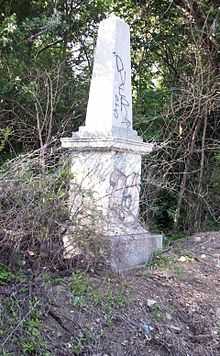Newkirk Viaduct Monument
Coordinates: 39°56′22″N 75°12′38″W / 39.939455°N 75.210619°W
| Newkirk Viaduct Monument | |
|---|---|
 2009 photo | |
| Coordinates | 39°56′22″N 75°12′38″W / 39.939455°N 75.210619°W |
| Location | West Philadelphia |
| Designer | Thomas Ustick Walter |
| Type | obelisk |
| Material | white marble |
| Width | 5 feet |
| Height | 14 feet |
| Completion date | 1839 |
| Dedicated to | Matthew Newkirk |
| Moved to present location sometime after 1927[1] | |
The Newkirk Viaduct Monument was erected in 1839 in present-day Philadelphia, Pennsylvania, by the Philadelphia, Wilmington and Baltimore Railroad to mark the 1838 completion of the Newkirk Viaduct, also called the Gray's Ferry Bridge, over the Schuylkill River. The bridge completed the first direct rail line between Philadelphia and Baltimore, Maryland — tracks that closely paralled the King's Highway, the main land route to the southern states.
On Aug. 14, 1838, the PW&B board of directors decided to name the bridge after company president Matthew Newkirk (1794-1868), a Philadelphia business and civic leader, and to commission a monument at its west end. (Earlier in the year, the company gave Newkirk a silver plate worth $1,000 ($21,922 today[ 1]) to reward him for arranging the merger of four railroads that together built the Philadelphia-Baltimore line.)[2]
Designed by Thomas Ustick Walter,[3] who would go on to design the dome of the U.S. Capitol, the white marble monument consists of a 7-foot obelisk atop a 5-foot-square base inscribed with the names of the officials of the four companies.[4][5]
The monument was installed along the western approach to the bridge and surrounded by a low iron fence.[4] An 1895 account describes its location as "on a high bank in the angle formed by the junction of the Philadelphia, Wilmington and Baltimore Railroad and the Chester Branch of the Philadelphia and Reading Railway just below the western end of the Gray's Ferry Bridge."[6]
In 1872, the PW&B built a new mainline west of the Viaduct, and leased its old line to the Reading Railroad, which expanded the old track to a small railyard.[1] In 1900, an article about the Viaduct's replacement noted the monument, and said, "On account of its inaccessibility and the dense foliage, it is scarcely ever seen."[7]
It was moved to its current location, along a right-of-way first laid in 1872, at some point after 1927.[1]
Today, the monument is abandoned, in disrepair, and nearly forgotten. It sits on the north side of Amtrak's Northeast Corridor tracks just to the north of the 49th Street Bridge, visible from Amtrak trains and from SEPTA Regional Rail trains on the Airport Line and the Wilmington/Newark Line.[5]
Inscription
The four sides of the monument and its base are inscribed as follows:[6]
| Obelisk | |||
|---|---|---|---|
President Vice President Directors Secretary, ALLAN THOMSON. AUBRY H. SMITH,[10] Ass't. |
BALTIMORE AND PORT DEPOSIT RAILROAD COMPANY President Directors Secretary and Treasurer, Engineer, Assistant Engineer, |
DELAWARE AND MARYLAND RAILROAD COMPANY. President, Directors: Engineer, Assistant Engineer, |
WILMINGTON AND SUSQUEHANNA RAILROAD COMPANY. President, Directors Secretary, Treasurer, Engineer, Assistant Engineer, |
| Base | |||
THE PHILADELPHIA WILMINGTON AND BALTIMORE RAILROAD COMPANY Formed A.D. 1838 by the
Union |
Railroad Contractors: Superintendents: |
NEWKIRK VIADUCT Samuel H. Kneass, Engineer. |
NEWKIRK VIADUCT Commenced July 4, 1837. |
External links


- Kelly, Sara (2002-05-01). "I Wanna Know". Philadelphia Weekly. Retrieved 2009-06-06.
- Maule, Bradley (March 13, 2013). "Wrong Side Of The Tracks: Newkirk Viaduct Monument In Photos". Hidden City Philadelphia. Retrieved March 15, 2013.
- Spivak, Joel. "Newkirk Viaduct Monument". Society for Industrial Archaeology Car Barn Tours. phillytrolley.org. Retrieved 2009-06-06.
| Wikimedia Commons has media related to Newkirk Viaduct Monument. |
References
- ↑ 2.0 2.1 "1838 (June 2004 Edition)". PRR CHRONOLOGY. The Pennsylvania Railroad Technical & Historical Society. June 2004. p. 2. Retrieved 23 July 2013.
- ↑ "Newkirk Viaduct". Philadelphia Architects and Buildings. The Athenaeum of Philadelphia. Retrieved 2013-06-10.
- ↑ 4.0 4.1 Dare, Charles P (1856). Philadelphia, Wilmington and Baltimore railroad guide: containing a description of the scenery, rivers, towns, villages, and objects of interest along the line of road; including historical sketches, legends 1. Fitzgibbon & Van Ness. p. 115.
- ↑ 5.0 5.1 Baer, Christopher (2002-05-08). "Do You Wanna Know More?". Philadelphia Weekly. Retrieved 2009-06-06.
- ↑ 6.0 6.1 Wilson, William Bender (1895). History of the Pennsylvania Railroad Company with Plan of Organization, Portraits of Officials and Biographical Sketches 1. Philadelphia: Henry T. Coates & Company. pp. 296–299. Retrieved November 25, 2012.
- ↑ "City's Fine New Bridge". Philadelphia. Philadelphia Record. August 12, 1900. p. 15. Retrieved September 25, 2013.
- ↑ The spelling of the last name seems to be in error; it should be "Connell". Minor, D.K. and George C. Schaeffer, editors (January 21, 1837). "Wilmington and Susquehanna Railroad Company". 132 Nassau Street, New York, New York. American Railroad Journal and Advocate for Internal Improvements. p. 34. Retrieved 18 August 2013.
- ↑ Notes for William Parvin BROBSON
- ↑ Misspelled; it is spelled "Aubrey". Annual Report of the Philadelphia, Wilmington and Baltimore Rail Road, 1838-40. Philadelphia: Philadelphia, Wilmington and Baltimore Rail Road Company. 1838-40.
- ↑ JHBL Family Genealogy
- ↑ 12.0 12.1 [sic] His last name was spelled "Tatnall"."Records of Vice President Henry Tatnall, 1897-1940 (bulk 1909-1940).". Hagley Museum and Library - Manuscripts and Archives Department. Worldcat. Retrieved October 1, 2013.
- ↑ Greenbury Purnell (1794 in Maryland-April 15, 1857, in Elkton, Maryland). Married Mary E. Megredy (b. December 30, 1805, in Elkton) On December 22, 1835. They had five children. Ancestry.com: JOB(E) LEGACY
- ↑ Son of superintendent Charles Lombaert. Later the assistant to Pennsylvania Railroad chief engineer Herman Haupt and ultimately a vice president of the PRR.